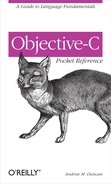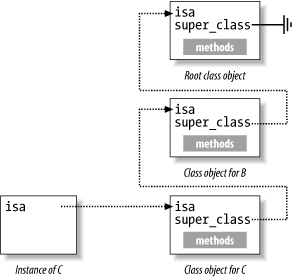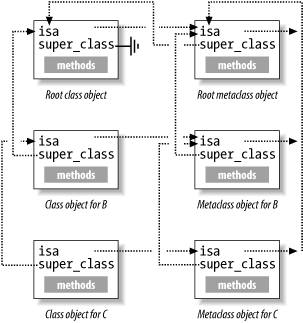When your Objective-C program is running, certain structures and services are always set up for you, even though you don’t specifically ask for them. These serve as the counterpart to the compiler: together the compiler and the runtime implement the features that Objective-C adds to C. Most languages include runtime environments; Objective-C is distinctive in exposing a good part of its runtime in a public programming interface.
The runtime’s interfaces are in header files that will be present in any installation of gcc. (For example, in Darwin they reside at /usr/include/objc. Check your compiler’s default include paths to locate these files.) You can also download the source code for the runtime; examining it is a good way to learn more about how dynamic languages are implemented.
Class objects are objects that represent at runtime the classes a program is using. Because they function in the same way as regular objects—you can send them messages and use them in expressions—Objective-C unifies the treatment of classes and their instances.
Class objects are also called factory objects, because in their
most common usage you send them the +alloc message to create other objects.
Class objects are set up by the Objective-C compiler and
initialized at runtime before your code needs to use them. To get a
class object from an instance, use the -class method. For example, given an instance created this
way:
Circle*c= [Circlenew];
you can retrieve the class object of that instance like this:
ClasscircleClass= [cclass];
Sending a message to a class object is common enough that it has
a shortcut: just name the class as the receiver, as you do when you
invoke +alloc.
In the Objective-C runtime all regular objects start with an
isa field, pointing to their class object. The class object
contains (or refers to) the instance methods that the object can
respond to. In addition each class object has a super_class pointer which refers to the parent class object. For root classes—those that have no
parents—super_class is set to
Nil. Figure 1-1 illustrates how
isa and super_class work together to define the
inheritance-chain for an object of class C, which inherits from class
B and the root class.
Runtime method dispatch for regular objects follows this sequence:
Follow the receiver’s
isamember to its class object.Search for the method in the class object’s method list.
If the method is not found, follow the class object’s
super_classpointer to the parent class.Repeat steps 2-3 until the method is found, or the root class’s
super_classpointer (which isNil) is evaluated.If the message is still not handled, call the object’s
-forward:: method. BothObjectandNSObjectprovide this method. (NSObject’s version is private.) The default forwarding behavior is to abort the program.If the object has no forwarding method, the program exits with an error.
The call to the forwarding method completes the method dispatcher’s role in performing the original method call: it has now been transformed into a different call (which is dispatched with the same mechanism). The Section 1.11 describes the subsequent steps in processing an unhandled message.
If instance methods are stored in class objects, then where are class methods stored? Class objects themselves have other objects to store the methods they respond to; these are called metaclass objects.
Like regular objects, class objects point to their metaclass
objects with an isa field.
Note
The isa field of a class
object is not inherited from a root class, but specified in the
declaration of Class in
objc.h. Its name varies across implementations;
this handbook uses isa for
clarity. isa is the name used in
Darwin.
This design allows class method invocation and lookup to proceed
exactly the same way as for instance methods. Class objects stand on
an equal footing with other objects in Objective-C: you can assign
them to variables declared as id, send messages to them, and they
inherit (class) methods from their ancestors.
The runtime relation between classes and their metaclasses is illustrated in Figure 1-2.
Metaclass objects are identical in structure to class objects.
However, their isa pointers all
refer to the root metaclass. This is a practical measure to forestall
the need for an infinite hierarchy of meta-metaclasses. (Effectively,
the root class is the meta-metaclass of all its descendants.) Since
you don’t normally use metaclass objects, this is not a major blemish
on the consistency of Objective-C.
Note
The GNU runtime distinguishes between class and metaclass
objects more than the Darwin runtime does. In the GNU runtime there are
distinct Class and MetaClass types (although they are just
typedefs for identical structures). Some of the reflection methods
(like -isKindOf:) of Object behave differently from the Darwin
version when passed metaclass objects. The exact behavior of these
methods is described in the Section 1.10.
Figure 1-2 shows
one other distinctive asymmetry in the otherwise uniform structure of
the runtime environment: the root metaclass’s super_class pointer refers to the root class object. This means
that class objects behave as if they are instances of their root
class: class objects will respond not only to their own class messages
and those of their parent classes (including those of the root), but
also to instance messages of the root class.
For efficiency, method dispatch doesn’t look up method names
with string comparisons. Instead method names are mapped one-to-one
with selectors—variables of type SEL . This mapping is known to both the compiler and the
runtime system. If you want pass a method around as a parameter and
invoke it through that parameter, you can use a SEL along with one of the -perform : methods. (The Section 1.3.5 gives an
example of this.)
The runtime also defines objects for each protocol in your
program. You can retrieve these objects using the @protocol directive:
Protocol*p=@protocol(ProtocolName);
You can’t do much with a protocol instance except pass it to
root class methods that take protocols as parameters, or send the
-conformsTo: message to it in order
to see whether it conforms to yet another protocol.


